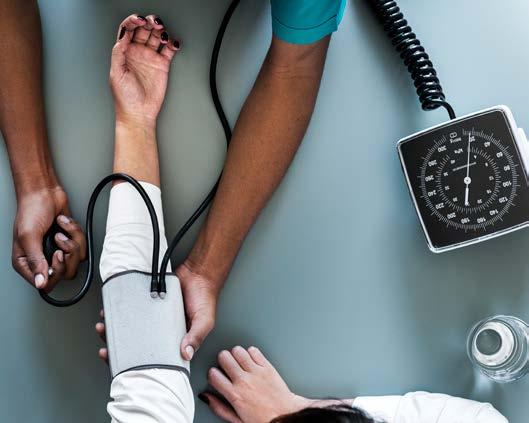
3 minute read
Hypertension… Did you get a high blood pressure reading? What to do next?
By Dr. Malak El Ess, Specialist Internal Medicine at Al-Ahli Hospital / Qatar
Hypertension is defined as a systolic blood pressure of 140 mm Hg or more, or diastolic blood pressure (DBP) of 90 mm Hg or more.
Advertisement
What is the latest classification of hypertension?
ACC/AHA classification 2017
1. Elevated blood pressure with systolic pressure between 120 and 129 mm Hg and diastolic pressure less than 80 mm Hg 2. Stage 1 hypertension, with a systolic pressure of 130 to 139 mm Hg or a diastolic pressure of 80 to 89 mm Hg 3. Stage 2: Systolic 140 mm Hg or greater, diastolic 90 mm Hg or greater
Is one reading of high blood pressure enough to diagnose hypertension?
No, to diagnose hypertension, we need an average of 2 readings on 2 different occasions.
What is white coat hypertension?
It is when patients have elevated BP readings in the clinic with normal BP readings at home. Patients with such presentations may have an increased risk for cardiovascular disease
“White coat hypertension can be further investigated with ambulatory BP monitoring (monitor attacked to the patient for 24 hrs) ‘’
What causes hypertension?
Hypertension can be either primary or hypertension which accounts for more than 90% of the cases or secondary hypertension which is much less common and usually is due to renal, vascular, endocrine disorders, or sleep apnea.
How does hypertension present?
Commonly high BP is silent and goes on for years without symptoms, some patients will present in advanced stages with headaches, nose bleeds, and breathlessness.
What are the complications of high blood pressure?
• Stroke • Angina, Myocardial infarction, Heart failure • Peripheral artery disease • Chronic kidney disease. • Vision loss • Sexual dysfunction
How to measure your blood pressure?
• Sit relaxed for five minutes • Avoid caffeine, exercise, smoking and empty bladder before checking. • Use a proper BP device and put the cuff at the heart level • Record BP in both arms and choose higher reading, repeat in 2 minutes if needed • Keep a record of your blood pressure readings for comparison
• What tests are needed in Hypertension evaluation?
• CBC, Urinalysis • Fasting blood glucose or A1c • Serum sodium, potassium, creatinine, and calcium • TSH, lipid profile
In addition to an ECG and possibly echocarHYPERTENSION CAN BE EITHER PRIMARY OR HYPERTENSION WHICH ACCOUNTS FOR MORE THAN 90% OF THE CASES OR SECONDARY HYPERTENSION WHICH IS MUCH LESS COMMON AND USUALLY IS DUE TO RENAL, VASCULAR, ENDOCRINE DISORDERS, OR SLEEP APNEA.
diography. If secondary HTN is suspected then more tests are needed:
What is the treatment of hypertension?
• Lifestyle modifications: Best results if 2 or more of those modifications were done • Weight loss, using DASH diet rich in fruits and vegetables; can reduce systolic BP by 5-20 mmHg for each 10 kgs dropped • Limit smoking and alcohol intake • Reduce sodium intake to less than 1.5 grams of sodium daily; can reduce systolic BP by 5-6 mmHg • Aerobic exercise at least 30 minutes daily for five days; can reduce systolic
BP by 5-8 mmHg • Maintain adequate intake of dietary potassium, calcium and magnesium
Medications
If lifestyle modifications fail to control blood pressure, then the patient should be started on medications that are chosen according to his age, race, other medical comorbidities and the stage of hypertension. This should be discussed individually with physicians there are multiple classes of antihypertensive with a different modes of action and indications.











